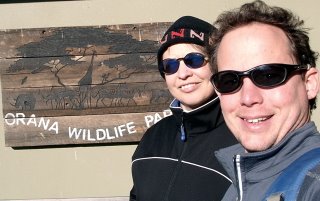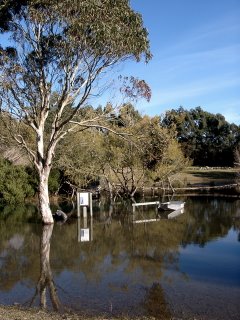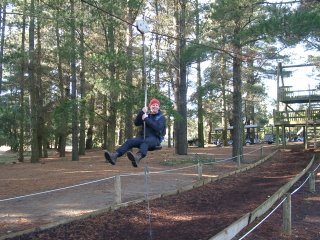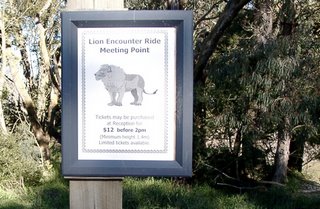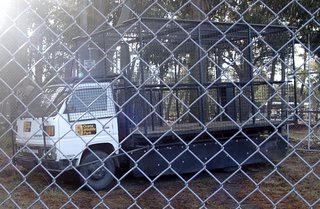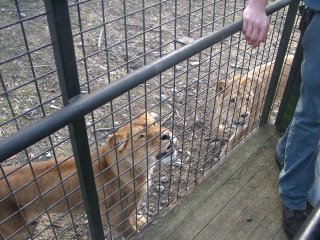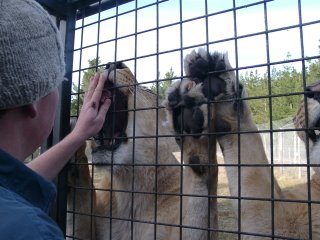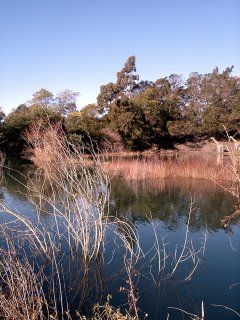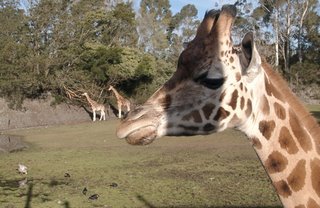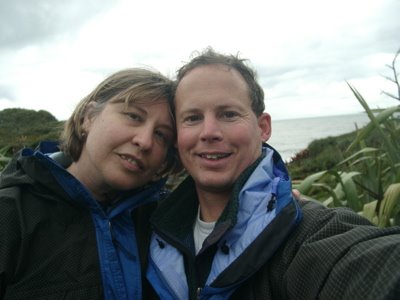Playing on the West Coast
I managed to get away last weekend for a couple of days of fun on the West Coast of the South Island. I joined a group of friends to look for caves in an area between Greymouth and Westport, along the West Coast. I have not had the chance for much cross country travel (called bushwhacking in New Zealand) and was excited about the trip. We left Christchurch around 6:00 A.M. Friday and drove west over Arthur's Pass. The weather has been cold lately and we were all a bit surprised to see how much snow has fallen in Arthur's Pass. Our clear weather window held however, and we made it over the pass with no trouble. We made a quick stop at a cafe and I purchased a couple of savory meat pies to hold me over until dinner. Once our appetites were satiated we were eager to get into the bush. After a short time we parked the truck and geared up for our day of bushwhacking.
We ascended a ridge, fighting our way through the sometimes dense bush. I had the chance to get acquainted with a wonderful plant called supplejack. I don't think this vine has leaves because I never did see where the vines led to. The vines are generally about as thick as your index finger and have the annoying habit of growing in lazy loops and arches and occur in sufficient numbers as to catch on everything - arms, legs, boots, packs, etc. All of us experienced a bit of "bushrage" at one point or another :-)

The flora and fauna was amazing! Aside from the supplejack, we encountered cabbage trees, lancewood, tree ferns, kauri, and many other beautifully green and luscious plants. Curious robins would flitter about, land on a rock or branch within a meter or two and watch what you were doing. No doubt they were thankful for the insects we disturbed.

Our goal was to look for cave entrances. However, the bush was so thick in places you could be standing within 5 meters of an entrance and not see it. I could not help but think about search principles like "Probability of Detection." Sufficient coverage of this area would be difficult. I am sure we unknowingly walked by as many entrances as we found.

We found many entrances, but most were either blocked with silt or constrictions which were two small to negotiate. However, it only takes one small passage to connect to a larger system within the ridge, and chance to find virgin (unexplored) cave drove us onward.

At the very end of the day - as is usually the case - we found an interesting feature: A tomo (vertical entrance) with what looks to be a 20 meter drop. We had to leave this cave to explore at a later date as it was getting late and we wanted to get back to the main trail by nightfall. What a wonderful experience! We may not have covered much ground, but there are enough interesting features in this area to make us all want to return. Now we have another goal: to find out where this cave goes.
We got back to our car around 6:00 P.M. and headed back into town to grab a bite to eat. After a relaxing dinner of fish and chips we drove back to Greymouth and stayed with a West Coast caver for the night.
I began the weekend with a bit of play on Friday. We then went to work on Saturday (well, ok, this is really playing also :-). On Saturday our group joined up with a few folks from the West Coast who are all involved in cave rescue. Our goal for the day was to rig a mineshaft to lower an attendant to the bottom (if possible) and back up. Some folks told a story about a person who disappeared many years ago in the area (the body was never found), and it might be possible that this mineshaft could have been the final resting place. Who knows? However, the area is riddled with mineshafts from a previous era of gold mining. The story did, however, add some interest to the operation.
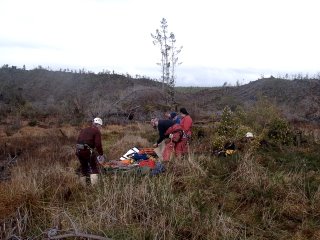
We measured the pitch with a rope tied to a rock and measured it at about 20 meters, although we were not sure if the shaft continued at an angle or not. This mineshaft was dug into alluvium. Large cobbles lined the walls of the shaft, and we watched as some of the cobbles spontaneously dislodged from the wall to crashed to the bottom. Because of the dangerous objective rockfall hazard, we decided to rig the shaft with a deflection so we could lower an attendant into the shaft without disturbing the walls.

As this was a rescue practice, we all got the chance to hone our rigging skills by setting up the rope systems. Part of our training included a short presentation about the dangers of bad air present in many mines, and we were encouraged to observe proper safety procedures by utilizing an oxygen monitor. We were also reminded of proper belay technique. After these presentations we set out to rig two tripods, one on either side of the shaft, rig the haul system for the deflection, and the haul system and belay for the attendant.

After a quick lunch we commenced the operation, and a brave soul was lowered down the shaft. Actually, due to the instability of the shaft, the attendant was only lowered about 2 meters before being hauled back to surface.
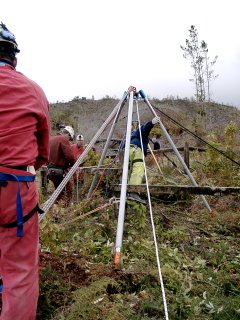
Well, we did not solve the mystery of the missing person, but we all had a great day of training! I still wonder what's down there, but I will let someone else find out.
We wrapped up the operation as rain started to fall. We left shortly after packing the truck because we had to drive over Arthur's Pass back to Christchurch. Luckily, only rain fell in the pass and we soon made it back home.

